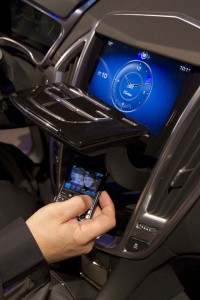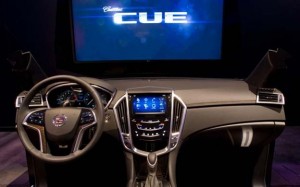Ever since Motorola introduced the first primitive in-car radio motorists have been demanding more and better onboard electronics – and these days, some cars offer better technology than you’ll find in the typical home or office.
But that raises another challenge: how to provide simple and intuitive controls for all that technology so the car’s cabin doesn’t like the crowded cockpit of a fighter jet. We’ve seen some creative solutions – from BMW’s iDrive to Ford MyTouch — that have created problems of their own, but now, General Motors is weighing in with what it bills as the even more advanced Cadillac Cue.
We got a chance to take the technology for a test drive, so to speak, ahead of its formal introduction at the L.A. Auto Show next week. And, while the prototype Caddy Cue still had some clear bugs to work out before its launch on the new 2013 Cadillac XTS sedan, we found that it clearly advances the state of in-car infotainment controls.

Caddy will offer a hidden storage center that can also charge a phone and link it to the Cue system.
(For more on the new Cadillac XTS, Click Here.)
The basics of the Cue system are not all that different from what you’ll find elsewhere. It features an 8-inch touchscreen display at the top of the center stack, as well as a 12.3-inch reconfigurable display replacing the traditional, mechanical gauge cluster visible through the steering wheel. There is a 5-way controller on the steering wheel and, with a touch of a button, you can activate voice-control.
But, as is often said, “it’s all in the details.”
In this case, Cadillac has started out with a handsome, high-resolution LCD display that doesn’t try to cram all too many details into the 8-inch monitor. When it’s operating it normally displays only the most pertinent information until it senses you want to do something – say change the satellite radio channel or plug in a destination for the navigation system.
But one of the breakthroughs with Cue is a technology known as proximity sensing – something you’ve undoubtedly experienced in a restroom with auto-on faucets.
Mounted inconspicuously below the screen, an infrared sensor detects the approach of your hand and signals the touchscreen to display additional information, such as a tuning button or a menu of navi options. But unlike an iPad or a conventional in-car touchscreen you get additional feedback, the screen of the Cadillac Cue providing a subtle but perceptible kick to confirm it has registered your choice.
“Cue can do things that are intuitive for devices we’re already familiar with,” suggested Jeff Massimilla, the Cue Program Manager.
Not only will it respond to a tap on its virtual buttons but it allows you to use tap, swipe and spread controls as you would on an iPhone or tablet computer. There are specific buttons you can use to zoom in or out on a map, for example, but it’s even easier to “pinch” the screen.
Significantly, the system is sensitive enough to respond to even a gloved hand – as long as you’re wearing leather – so you don’t have to go barehanded on a cold winter morning. And Caddy claims it has designed the system to sense and adapt to the car’s ambient temperature so it will work smoothly even in January in International Falls, Minnesota.
Our test found the system a little slow, at times, but we were warned of that ahead of time by Massimilla. He noted that the system had gone through a dozen updates in just the previous couple weeks and would likely experience dozens more before the Cadillac XTS rolls into showrooms.
You can also use a five-way controller mounted on the steering wheel, which also operates the large gauge cluster. Cadillac will let buyers opt for any of four separate displays, from a fairly conventional analog-like image, to something much more high-tech displaying lots of information about the music you’re playing and the route you’re taking. There’s also a performance-oriented display.
Perhaps the most significant breakthrough offered by the Cadillac Cue system becomes apparent when you opt for hands-free operation. Tap a button and Cue will listen to your every word. Quite literally. Until now, voice recognition systems have required a user to memorize frustratingly complex commands. To pair a phone with the current Cadillac CTS, for example, you must start by telling the system, “Phone,” then “Handsfree,” then “Bluetooth,” and finally “Pair Phone”… and only then actually begin the pairing process on your phone.
Cue shares the same Nuance-supplied voice “engine” found in most other in-car infotainment systems – but Cadillac programmers spend thousands of hours teaching it how to recognize conversational speech. Here you’ll be able tell Cue to “Pair my phone,” or even, “link up my phone.” You’ll be able to say, “I want to find a Chinese restaurant,” or “Where is the local bookstore?”
Again, the prototype we “drove” was in mid-development stage, so it wasn’t fully up to speed. But considering similar functionality is now being built into Apple’s latest iPhone 4S with the Siri app we’re confident Cue should work when brought to market. One book difference from Apple’s new system is that “Siri is in the ‘cloud,’” stressed Massimilla, while the Cue system is all onboard. So it’s capabilities are a bit more limited – but should be more than enough for what you’ll need while driving.
To handle all the demands, Cadillac has built three three-core microprocessors into Cue, each operating at 400 million operations per second. Two of those cores are dedicated to voice commands when needed.
As with most of the latest onboard systems, Caddy Cue will lock out certain functions when you’re driving – like entering a destination or responding to a text message. It will read messages to you and allow you to respond with one of 10 pre-set replies. A QWERTY keyboard can be popped up on screen once you stop.
Cadillac Cue will also access various smartphone apps, notably the Pandora music service, with more coming, we’re promised.
The infotainment system will be offered as standard equipment on the new 2013 Cadillac XTS, and as an option on the smaller Caddy ATS.
Based on our initial experience, Cadillac Cue could be one of the most significant updates to in-car technology we’ve seen, at least in terms of what techies call the “man-machine interface.” There’s still a lot of programming to do before it goes live, however.

